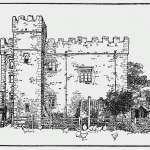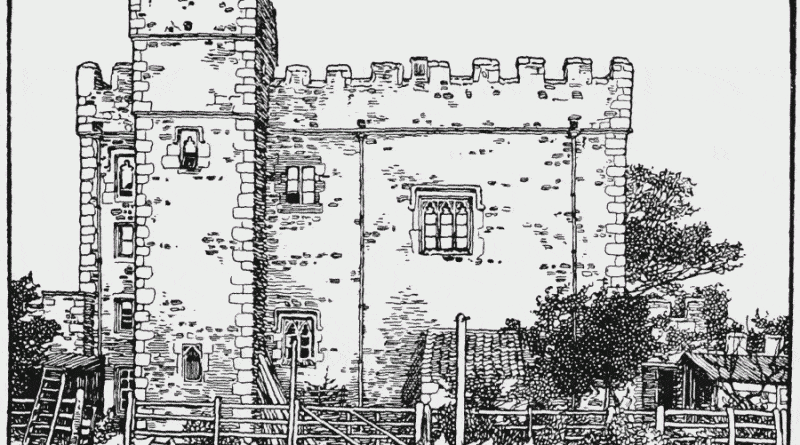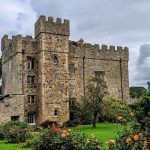South Cowton Castle
South Cowton Castle was built by Sir Richard Conyers. It has been dated variously to 1470 and a broader ‘late 15th century’. South Cowton lay in Richmondshire, an area in which there had been considerable unrest during the 15th century. As such, a fortification was of value as both a defensive structure and as a secured home.
Cowton Castle
Cowton Castle stands atop a plateau overlooking the now abandoned village of South Cowton. A prominent site, it was built by Sir Richard Conyers who also paid for the construction of St. Mary’s Church in South Cowton and a cobbled causeway linking the Castle to the Church. The castle, church and causeway are all intact to this day, though restoration work is required on the causeway. The church is open to visitors whilst the Castle is now used as a farmhouse and is not open to the public.
South Cowton Castle. Photograph kindly provided by smharrisonwriter.com.
Layout and design
Cowton Castle consists of a signle quadrangular tower. The dimensions of the tower are a base of 60 feet by 25 feet. The tower is 3 storeys high. At the top of the tower are turrets that project outwards and upwards from the main building. These are found on the north-eastern and north-western corners of the tower. The former measure 15 feet six inches by 6 feet six inches and the latter 9 feet by 6 feet 6 inches. The tower construction is largely of rubblestone with ashlar dressings.
Interior of Cowton Castle
Victoria County History describes the interior of the tower as having been:
Ground floor: four-centred-arched door with two-light plate traceried overlight and hoodmould. Windows in chamfered- quoined surrounds. To left 3-light plate-traceried window with hoodmould. To right, a 2-shouldered-arch-light window. First floor: 3-light window with relieving arch to left. Central 2-light window with relieving arch. To right 2-shouldered-arch-light window with single-light window above and below. Stair tower on right has one-light pointed-arch windows with flat hoodmoulds. Carved stone panel in between first-and second-floor windows. Embattled parapets. South-west elevation has 2-light window and 3-light window, chamfered, with cusped-pointed arches and flat hoodmoulds. Interior: north-east tower has spiral stone stair.
Victoria County History. via British History Online.
Cowton: an important location
Cowton is in Richmondshire. In the early 15th century the area saw men participating in the Percy Revolt that culminated in the Battle of Bramham Moor. It then experienced regional violence in the 1440-50’s when the Percy-Neville Feud was at its peak. As the Wars of the Roses started it was close to the rival bases of both the Percy and Neville families and close to the areas in which the Lancastrian’s held out for a period after their defeat in the Battle of Towton. Most pertinently to Sir Richard Conyers, perhaps, was that there had also been a revolt in 1469 in which branches of his family were implicated: though not Sir Richard himself.
Wars of the Roses
Though held by Sir Richard Conyers from the Neville’s of Middleham, South Cowton was actually leased out from 1462. Richard Pigot, a retainer and Councillor of the Earl of Warwick and later Richard Duke of Gloucester, took a twenty year lease on the capital messuage of South Cowton in 1462. He also leased other Manors. Pigot is also known to have sublet some of the lands that he had leased. It results in Cowton Castle and the village of South Cowton becoming more valued as farming land than as a fortified position.
Redesdale Revolt
Sir Richard’s brother, Sir John Conyers, is one of the men who organised and led the Robin of Redesdale revolt. This saw men raised against King Edward IV in the Yorkshire Dales, with many coming from areas close to Cowton.
South Cowton village ‘abandoned’
South Cowton village lay adjacent to the castle. Until 1489 the village itself was held from the lords of Middleham. 1489 saw the village being acquired by Sir Richard Conyers. It seems that the village was already in decline at the time. However, Sir Richard completed its end by evicting the remaining 20 residents. He also demolished the 4 houses that were left in the village. This was done in order to enable Sir Richard to enclose the 120 acres of land taken up by the village and it’s fields for the purpose of it becoming a managed pasture. [Pollard p58, North Yorkshire County Records Office zjx/3/2/75, 80, 83, 11]
South Cowton Castle Links
Historic England – Cowton Castle. Official listing.
Historic England – South Cowton abandoned Medieval village. Located to the immediate south west of South Cowton Castle.
Heritage Gateway – Historic England’s research references for Cowton Castle.
Gatehouse Gazetteer – Cowton Castle. Sources.
Britain Express – St. Mary’s Church, South Cowton. Built by Sir Richard Conyers in the 15th century.
Featured Image


